Haßloch, Germany – Sunday, March 28th, 2010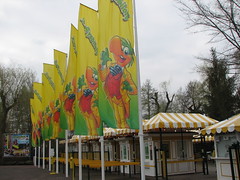
I’m an hour late due to daylights savings. I assumed my phone would automatically reset for the change-over, but it didn’t. Oh well, I needed the extra rest. The taxi fare jumps another 10 eurocents. I suspect the driver is taking the long way to the park to chisel as much extra from the dumb American tourist as he can. This is not the main object of my concentration, which is scanning the passing tree lines looking if I can catch my first glimpse of the track through the foliage. It’s a long shot that doesn’t pay off, but at least it distracts me from the fact that the fare rose to a good 15 euro by the time we arrived at the entrance. Whatever. What matters is that I’m finally at the gates of Holiday Park.
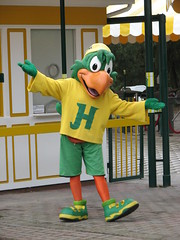 The day is frankly not an idea one to spend at a park, a thick, gray blanket of clouds shielding us from the sun and a faint mist in the air threatens the potential of rainfall but it seems to be staved off for the moment. I can see this means that no one else is here, very good news for me. Holly the Parrot perks up when he sees a potential guest get out of the cab, shaking my hand as I buy my admission ticket. If it’s obvious to them I’m not from the country, they don’t comment on it. Despite being a small park they do have a particular attraction that they must be used to people traveling great distances from all over the world for. That’s certainly the reason I’m here today.
The day is frankly not an idea one to spend at a park, a thick, gray blanket of clouds shielding us from the sun and a faint mist in the air threatens the potential of rainfall but it seems to be staved off for the moment. I can see this means that no one else is here, very good news for me. Holly the Parrot perks up when he sees a potential guest get out of the cab, shaking my hand as I buy my admission ticket. If it’s obvious to them I’m not from the country, they don’t comment on it. Despite being a small park they do have a particular attraction that they must be used to people traveling great distances from all over the world for. That’s certainly the reason I’m here today.
Inside the gates, an abundance of foliage blocks the view beyond the main entry plaza, which I find nearly humorously unassuming. A mental note is made of it, and then I move on. My walk attempts to imitate my impression of someone enjoying a casually relaxed day at the park on an early spring weekend, but secretly I couldn’t be more anxious as I wonder what my first glimpse of the ride will be. Will I catch the lift hill sticking above the trees, or the final turn into the station, or some other random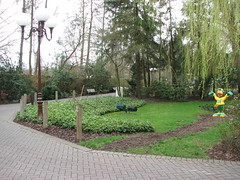 part of the layout? It’s an odd parasocial relationship one can have with a roller coaster they have read and dreamt much about, feeling as if they’ve already ridden it a hundred times through photos and POV YouTube videos online. And yet when you’re actually there in person, the realization that what you see is real and not a collection of pixels hits you like a flying brick wall.
part of the layout? It’s an odd parasocial relationship one can have with a roller coaster they have read and dreamt much about, feeling as if they’ve already ridden it a hundred times through photos and POV YouTube videos online. And yet when you’re actually there in person, the realization that what you see is real and not a collection of pixels hits you like a flying brick wall.
My retina catches the first light particles reflected off its metallic track. The little part of my brain that makes my hair stand on end is subsequently hit by a flying brick wall.
As I make my way up to the station the operators seem calmly ambivalent about their occupations as they welcome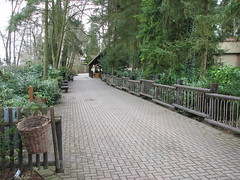 me to choose an empty seat. “Don’t you realize what an honor it is to be operating a roller coaster of such worldwide significance?” I refrain from asking them this, if only because I do not know how to say it in German.
me to choose an empty seat. “Don’t you realize what an honor it is to be operating a roller coaster of such worldwide significance?” I refrain from asking them this, if only because I do not know how to say it in German.
Every seat on the six car train is waiting empty for me to choose, save unfortunately for the two in the very front, so I decide rather than wait any longer to take the back; in all honestly that’s probably going to be the best seat on the ride. I climb in, pull the restraint secure. After waiting a few minutes for more guests to arrive, the operators run their check, and the train is dispatched.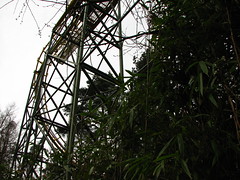
The train breaks free of the lift and my back car is spun down and around the twisting first dive. Every moment that follows is pure bliss, the work of a master coaster designer at the height of their form. This is exactly how I wish every steel roller coaster in the world could feel, but sadly few in the time since have come close to duplicating the sensations produced on this one. Perhaps most importantly… as the banking whips the car back to level, greeted with a moment of hard, sustained airtime on the rest of the drop before hitting a hard pullout… it was a ride to actually feel. All too often the act of riding a coaster becomes merely a formality provided one has familiarized themselves with the POV footage. This coaster one must experience for themselves, as an individual’s unique response to the ride can have a dramatic affect on the dynamics experienced, partly owing to the fact that the dynamics present over the course of a single circuit are about as unusual and pushed to the limits as they come.
as an individual’s unique response to the ride can have a dramatic affect on the dynamics experienced, partly owing to the fact that the dynamics present over the course of a single circuit are about as unusual and pushed to the limits as they come.
A re-ride in the front rows is mandatory, in order to see firsthand and appreciate the little nuances which make this trackwork so advanced. While the lift over hills and valleys is presently superb as expected, the delight is in observing how these undulating motions are integrated with banked curves of all varying radii, sometimes done within the constraints of extremely narrow transition lengths. The cars twist around their axis on heartlined turns, slamming everyone to the side and keeping them 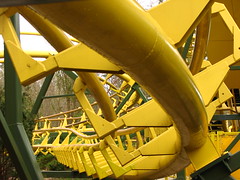 guessing as the geometer behind the layout’s blueprints gleefully plays with his literally captive audience, plugging all manner of mathematical equations into one another, packing far too much track into far too little spaces, producing results which at times can be frankly horrifying… but this designer knows exactly where the limit is, taking us straight to the edge before pulling us back with a magical flash of calculus. Unfortunately for many spoon-fed on today’s breed of B&M designs this coaster may still prove all too intense for them, which is perhaps just as well as it is the only real way to separate the children from the adults in the world of coaster enthusiasses.
guessing as the geometer behind the layout’s blueprints gleefully plays with his literally captive audience, plugging all manner of mathematical equations into one another, packing far too much track into far too little spaces, producing results which at times can be frankly horrifying… but this designer knows exactly where the limit is, taking us straight to the edge before pulling us back with a magical flash of calculus. Unfortunately for many spoon-fed on today’s breed of B&M designs this coaster may still prove all too intense for them, which is perhaps just as well as it is the only real way to separate the children from the adults in the world of coaster enthusiasses.
Of course this was built long before manufacturers got it into their heads that a wheel assembly needs to grip the  track tighter than a six year old on their bicycle with their training wheels
track tighter than a six year old on their bicycle with their training wheels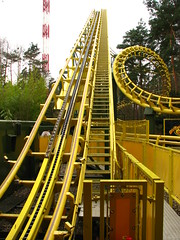 off for the first time, supposedly under the delusion that it will make the experience smoother, when all it really does is require they design neutered layouts that prevent the slightest bumps from appearing lest these ‘imperfections’ ride all the way up from the rigid contact between the wheels to the seat into the spine of the rider. You want a bit of slack between wheel and track, this lets the damn thing actually coast freely and smoothly over the rails, and with just the right amount of play one can get a feel of what the gravity is actually doing to the cars and let the full personality of the design shine like a jewel, while making sure no two cycles are ever exactly the same.
off for the first time, supposedly under the delusion that it will make the experience smoother, when all it really does is require they design neutered layouts that prevent the slightest bumps from appearing lest these ‘imperfections’ ride all the way up from the rigid contact between the wheels to the seat into the spine of the rider. You want a bit of slack between wheel and track, this lets the damn thing actually coast freely and smoothly over the rails, and with just the right amount of play one can get a feel of what the gravity is actually doing to the cars and let the full personality of the design shine like a jewel, while making sure no two cycles are ever exactly the same.
 The train hits the brakes, rounds a flat right turn and I disembark fully satisfied with my ride, only slightly sad that I’ll no longer be able to look forward to riding it for the first time ever again. Walking away from its bright yellow structure I think to myself, “how unfortunate that so many people will purposely skip the opportunity to experience for themselves this magnificent design, especially as it’s a pioneer in the history of modern steel roller coasters.” I promise I’ll be back later for more re-rides after exploring the rest of the park as I catch one last glimpse of the retro-German lettering on the station spelling Super-Wirbel.
The train hits the brakes, rounds a flat right turn and I disembark fully satisfied with my ride, only slightly sad that I’ll no longer be able to look forward to riding it for the first time ever again. Walking away from its bright yellow structure I think to myself, “how unfortunate that so many people will purposely skip the opportunity to experience for themselves this magnificent design, especially as it’s a pioneer in the history of modern steel roller coasters.” I promise I’ll be back later for more re-rides after exploring the rest of the park as I catch one last glimpse of the retro-German lettering on the station spelling Super-Wirbel.
Nearby is the Bounty Tower, a HUSS Condor ride which always prove to be worth a cycle even if they’re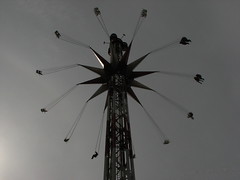 not particularly white knuckle. A similar spinning tower ride next door would prove more apt for that description is the Lighthouse Tower, my first encounter with a Star Flyer not on a pay-per-ride basis. The prospect of being lifted up 250 feet while being secured only in a basic chairswing seat held by chains seems a rather frightening one to consider, although as there’s nothing particularly thrilling about the dynamics itself, the ride’s effectiveness depends more on how victim to acrophobia and vertigo one is. I can get bad vertigo if I also sense I am standing freely on my own two feet
not particularly white knuckle. A similar spinning tower ride next door would prove more apt for that description is the Lighthouse Tower, my first encounter with a Star Flyer not on a pay-per-ride basis. The prospect of being lifted up 250 feet while being secured only in a basic chairswing seat held by chains seems a rather frightening one to consider, although as there’s nothing particularly thrilling about the dynamics itself, the ride’s effectiveness depends more on how victim to acrophobia and vertigo one is. I can get bad vertigo if I also sense I am standing freely on my own two feet 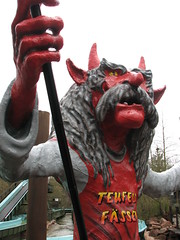 and have the potential to fall (glass-bottomed floor on the CN Tower, forget about it!) but when I feel secured to something like a roller coaster car or drop tower seat then I’m fine with no problems. The chairs on the Lighthouse Tower were minimalist at best so I wasn’t sure how I would respond, but I discovered that simply by being seated in a chair, no matter how exposed, got me off my feet and as a result I encountered no nervous feelings whatsoever. Actually I sort of wish they placed it closer to the center of the park as after a minute of cycle it became a bit boring without the views of not much else but endless trees and countryside.
and have the potential to fall (glass-bottomed floor on the CN Tower, forget about it!) but when I feel secured to something like a roller coaster car or drop tower seat then I’m fine with no problems. The chairs on the Lighthouse Tower were minimalist at best so I wasn’t sure how I would respond, but I discovered that simply by being seated in a chair, no matter how exposed, got me off my feet and as a result I encountered no nervous feelings whatsoever. Actually I sort of wish they placed it closer to the center of the park as after a minute of cycle it became a bit boring without the views of not much else but endless trees and countryside.
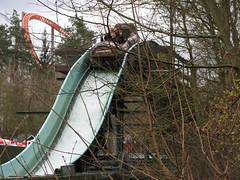 One of the other standouts in the park is Teufelsfässer, aka the Devil’s Barrels. I’m not sure if this was built before or after the Bathtub Ride at Tripsdrill as they seem clearly inspired by each other, the Devil’s Barrels being more spread out, stripped down and rustic, making it also feel more familiar to me as I’m used to the old Arrow flumes at American parks built in the 70’s. Three drops, reversing sections with indoor dark ride segments was all there, as too were leisurely meandering troughs through the woods with a long double-dip splashdown finale. Didn’t get more than a sprinkling of water on any of the splashes, which was good considering the
One of the other standouts in the park is Teufelsfässer, aka the Devil’s Barrels. I’m not sure if this was built before or after the Bathtub Ride at Tripsdrill as they seem clearly inspired by each other, the Devil’s Barrels being more spread out, stripped down and rustic, making it also feel more familiar to me as I’m used to the old Arrow flumes at American parks built in the 70’s. Three drops, reversing sections with indoor dark ride segments was all there, as too were leisurely meandering troughs through the woods with a long double-dip splashdown finale. Didn’t get more than a sprinkling of water on any of the splashes, which was good considering the  weather was still rather chilly and gray. That was also part of the reason I would end up skipping the Donnerfluss rapids ride, although also because I ran out of time before my interest in doing that one exceeded my interest in other potential activities.
weather was still rather chilly and gray. That was also part of the reason I would end up skipping the Donnerfluss rapids ride, although also because I ran out of time before my interest in doing that one exceeded my interest in other potential activities.
Towards the front of the park was the 230 foot Free Fall Tower, from my understanding one of the first of Intamin’s second generation magnetic braking drop towers. It was set in a large industrial ‘extreme’ plaza area which seemed slightly out of touch of the rustic aesthetic of the rest of the park, but as everything at Holiday Park is fairly eclectic anyway it doesn’t really matter (the name and theme would feel right at home in any 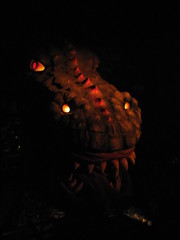 Cedar Fair park). The ride was the same as any other free fall tower of this sort, good because they don’t sully it with an attempt at faster-than-freefall drops, and being in the center of the park there are nice views to be had from the top. Walk-on queues this time of year are a nice treat as well.
Cedar Fair park). The ride was the same as any other free fall tower of this sort, good because they don’t sully it with an attempt at faster-than-freefall drops, and being in the center of the park there are nice views to be had from the top. Walk-on queues this time of year are a nice treat as well.
Burg Falkenstein represented the last of the major attractions at Holiday Park I’d need to sample, and I got there at a good time as the skies were just starting to open up to a light rain as I ducked into its turreted ingress. I recall lots of darkly lit scenes of medieval chivalry with a large dragon animatronic near the end being the most notable. If there was a narrative linking the scenes together I missed it, although I really didn’t care because there was a unique sense of atmosphere to this dark ride that felt like it could only come from this part of Europe.
could only come from this part of Europe.
I liked that Holiday Park didn’t try too hard to create their own atmosphere and instead let the natural surroundings do most of that work for them, their job was just to fill in the gaps with an eclectic but high quality assortment of rides. In that way I’d nearly say it felt more real than Erlebnispark Tripsdrill the day prior, although that one has enough strange “only in Germany” moments as well that it’s hard to compare. In some ways Holiday Park nearly reminded me of a Six Flags park crossed with Knoebels, if such a hybrid is even imaginable within the limitations of space and time.
Before I wrap up this report of Holiday Park I feel there is still one more ride of some importance I’ve forgotten to review. It wasn’t the new for 2010 mouse coaster Holly’s Wilde Autofahrt as that one had yet to be announced let alone built. I’ve already spent some time describing the peerless Super-Wirbel (not that it doesn’t deserve more of my words). Oh I remember, the semi-official number one rated steel coaster in the world (depending on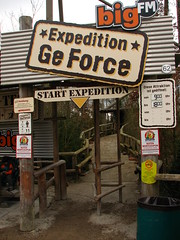 who you ask): Expedition GeForce.
who you ask): Expedition GeForce.
If it’s not been wholly evident from many of my other reviews I lack the same degree of enthusiasm for many of the top rated modern steel coasters that most other fans tend to share. I’d be lying if I said that Expedition GeForce was the single-most coaster in all of Europe I was anticipating. Nevertheless, I would also be lying if I said watching for the first time a train take a circuit around the track as I waited next set of front seats didn’t in some way give me a bit of a thrill. “There it goes down the first drop! Look how fast it’s flying over that first camelback! I can’t believe I’m actually here to witness this coaster in action, a few months ago I never would have imagined…!”
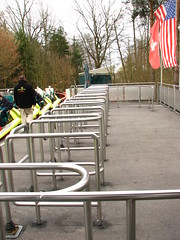 After watching it fly through the overbank which looked slightly more iffy in terms of pace, I lost track of the train for the next little while. It reemerged, returning over the final bunny hills. Oh crap, that train is going slow. I knew some cold morning, early season slowness should have likely been anticipated, but by the end of the layout this train appeared to be having trouble making it over the last hills without risking a rollback. Even after entering the brakes we still had to wait a good twenty seconds or so for the train to advance far enough out of fixed magnetic brake run to catch the first drive tire back to the station. I suddenly was boarding the train slightly apprehensive if I’d even enjoy my ride. Reflecting their coaster, the attendants were also rather slow in getting it dispatched but I wouldn’t fault them for it today as every train was being sent out with several empty rows, and that was even with the last three rows of seats filled with water dummies. (That it had one-train operation all day probably doesn’t need to be stated).
After watching it fly through the overbank which looked slightly more iffy in terms of pace, I lost track of the train for the next little while. It reemerged, returning over the final bunny hills. Oh crap, that train is going slow. I knew some cold morning, early season slowness should have likely been anticipated, but by the end of the layout this train appeared to be having trouble making it over the last hills without risking a rollback. Even after entering the brakes we still had to wait a good twenty seconds or so for the train to advance far enough out of fixed magnetic brake run to catch the first drive tire back to the station. I suddenly was boarding the train slightly apprehensive if I’d even enjoy my ride. Reflecting their coaster, the attendants were also rather slow in getting it dispatched but I wouldn’t fault them for it today as every train was being sent out with several empty rows, and that was even with the last three rows of seats filled with water dummies. (That it had one-train operation all day probably doesn’t need to be stated).
 Dispatch is given and up the elevator lift we go. We waste no time getting to the top, the elevator lift felt more rattly and lo-fi than I would have expected from this technology (especially being identical to the one-year older system on Millennium Force). The first drop is definitely a showstopper when you look at it, a 90 degree twist along an 82° drop seems to provide tantalizing possibilities for all sorts of absurd dynamics especially in the back of the train (a shame, as I already noted, the last three rows were all closed off today). My suspicion is this was developed as a ‘test’ for the 90 degree twisting drops to debut on Xcelerator the following year, although personally I think Expedition GeForce’s plunge may be more interesting as rather than simply twist around
Dispatch is given and up the elevator lift we go. We waste no time getting to the top, the elevator lift felt more rattly and lo-fi than I would have expected from this technology (especially being identical to the one-year older system on Millennium Force). The first drop is definitely a showstopper when you look at it, a 90 degree twist along an 82° drop seems to provide tantalizing possibilities for all sorts of absurd dynamics especially in the back of the train (a shame, as I already noted, the last three rows were all closed off today). My suspicion is this was developed as a ‘test’ for the 90 degree twisting drops to debut on Xcelerator the following year, although personally I think Expedition GeForce’s plunge may be more interesting as rather than simply twist around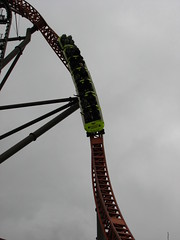 the heartline on a vertical drop, there’s some slight banking pitches thrown in as well to help navigate the less-than-90° fall, most obviously given away by the slight leftward counter-twist seen on POV videos when it start to reach the pullout.
the heartline on a vertical drop, there’s some slight banking pitches thrown in as well to help navigate the less-than-90° fall, most obviously given away by the slight leftward counter-twist seen on POV videos when it start to reach the pullout.
However this didn’t produce as spectacular results as I might have imagined, the twist actually muting any sensation of negative-g’s or the incredible steepness of the drop, as those dynamics are countered by the inward seat forces needed to accommodate the twist at such a steep angle. I was aware by looking at my surroundings we were approaching vertical, but my inner ear always insisted “nah, you’re not much steeper than 65°”. Sitting on the right side of the train helped somewhat as the twist would pull you down and around the heartline rather push you up around it. First drops can be a tricky thing in any circumstance since technically, if you are starting the drop near a speed of 0 and are sitting forward from the center of gravity, it’s impossible to design a parabola from that point which produces less than 0-g’s of vertical force, which is the very best you can hope for.
The pullout comes fast and the next element was, for me at least, the shining moment of the ride, the sustained negative-g camelback hill. It took me several rides until I realized just how scarce an element like this is for so many coaster, as it seems on most modern designs which attempt a tall camelback airtime hill like this, the best you can get is sustained floater or mild ejector air. Most ejector I’m familiar with is of relatively shorter durations so it was a surprise to get that force for this long. Good opening act, and thankfully, unlike B&M, Stengel and Intamin wouldn’t be content to simply repeat this same maneuver on ever-smaller scales with random turnarounds thrown in until the ride is complete, every element on Expedition GeForce from here on out has its own unique set of properties.
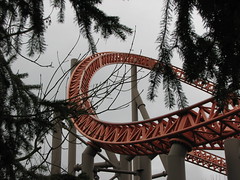 Take the next one, the first overbanked turn. Well, okay, I never find overbanked turns to be anything too special from a perspective of ride dynamics, but they can be made more interesting by looking (and maybe leaning) way over to your side if you happen to be on the inside of the turn. A fast pullout produces the next moment of sustained negative-g, a low camelback dodging underneath a section of track on the return run. This one keeps its speed more evenly sustained than the first camelback which is taller and more parabolic, but the force should be about as great. I say ‘should be’ because I believe I could already start to feel the effects of the early season slumps playing
Take the next one, the first overbanked turn. Well, okay, I never find overbanked turns to be anything too special from a perspective of ride dynamics, but they can be made more interesting by looking (and maybe leaning) way over to your side if you happen to be on the inside of the turn. A fast pullout produces the next moment of sustained negative-g, a low camelback dodging underneath a section of track on the return run. This one keeps its speed more evenly sustained than the first camelback which is taller and more parabolic, but the force should be about as great. I say ‘should be’ because I believe I could already start to feel the effects of the early season slumps playing with the frictional coefficients which causes the train to go ever-slower than intended the farther the ride goes on. Still a cool moment no matter what and I’m enjoying the ride thus far. In terms of dramatic sequencing it doesn’t deliver a stunning knockout punch the way better coasters such as Maverick or Nemesis are able, but I appreciate that it has a good sense of pacing and power, and is able for forcefully move us from one element to the next with a sense of clear purpose and destiny to the proceedings, unlike many newer speed coasters which feel like they’re indifferent towards what
with the frictional coefficients which causes the train to go ever-slower than intended the farther the ride goes on. Still a cool moment no matter what and I’m enjoying the ride thus far. In terms of dramatic sequencing it doesn’t deliver a stunning knockout punch the way better coasters such as Maverick or Nemesis are able, but I appreciate that it has a good sense of pacing and power, and is able for forcefully move us from one element to the next with a sense of clear purpose and destiny to the proceedings, unlike many newer speed coasters which feel like they’re indifferent towards what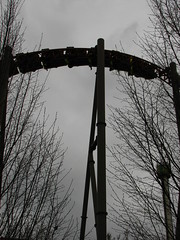 they want to achieve with each element.
they want to achieve with each element.
Then we get to the next element, a second overbanked turn over the rapids ride. I’m not a huge fan of the first instance of these but I put up with it because they at least provide some interesting perspectives for those on the right side of the train, do I really need a second one this soon just so the left side of the train can get the same thing? For those that need extreme g-forces at every moment to be satisfied with your ride, overbanked turns are the wrong elements to be building as they not only neutralize any laterals (which apparently are taboo on modern steel coasters anyway) but they also weaken the potential for strong positive g’s by slowing the ride’s speed down with the higher altitude, and also having to work counter to the downward pull of gravity. Under the best of times there might still be a bit of power in this turn, but as it was for me today, it was a rather ‘meh’ element; enjoy it for the views, but this isn’t the part that earns it the name “Expedition GeForce”.
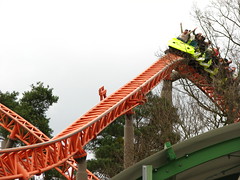 Neither is the next element, a sort of halfway-there overbank which rolls out at the top into a shallow downhill straight stretch of track with a trim brake on it. I’m so glad that when Stengel and Intamin came around to designing Intimidator 305 they abandoned these sweeping banked fan turns in favor of flat, ground level switchbacks, but apparently many are complaining of gray-outs and restraint problems on these parts so I’ll have to wait and ride it for myself to make a final judgment. But I actually do find this straight track sort of fitting in the context of the ride, as it comes more or less precisely at the halfway point in the layout, and it provides a moment to set-up and anticipate the beginning of the second half. Also a win: the magnetic trim brake was removed.
Neither is the next element, a sort of halfway-there overbank which rolls out at the top into a shallow downhill straight stretch of track with a trim brake on it. I’m so glad that when Stengel and Intamin came around to designing Intimidator 305 they abandoned these sweeping banked fan turns in favor of flat, ground level switchbacks, but apparently many are complaining of gray-outs and restraint problems on these parts so I’ll have to wait and ride it for myself to make a final judgment. But I actually do find this straight track sort of fitting in the context of the ride, as it comes more or less precisely at the halfway point in the layout, and it provides a moment to set-up and anticipate the beginning of the second half. Also a win: the magnetic trim brake was removed.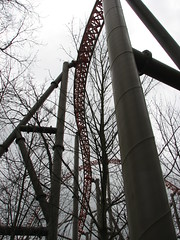
The train banks and pulls around to the right, still high above the ground, and the train pulls up into my favorite part of the second half, the right to left s-turn at the crest of a hill. Sit in the left side of the train (so you get ‘pulled down’ by the heartline rather than ‘pushed up’) and there’s a yummy pop of air mixed with the delightful rotational workout for the car’s chassis. Not scary or intense, just a random fun moment which also provides the most unusual dynamics of the whole ride, even moreso I’d say than the first drop (depends on if you’re sitting on the left or right side; I preferred the left just for this moment and getting to hang over 2 of the 3 full overbanks, although the right’s still better for the first drop and overbank, so whether you’d prefer port or starboard sides is a matter of personal choice).
The train then navigates up into a final overbanked turn… and by this point I’m falling out of the side, so little momentum does our train have remaining. That might actually work in favor for this otherwise unspectacular element, but unfortunately my sluggish velocity does nothing of service for the ride’s finale. In fact, why am I even going to bother analyzing this section, since all it’s going to get me are statements of “oh, that’s too bad you caught it on such a lousy day, it’s normally not like that, you should come back again sometime and you’re sure to like it much more.” Just so you know what I was getting, on my first batch of morning rides I wasn’t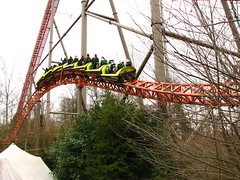 even getting close to floater air over any of these hills. Later in the afternoon the first two hops along the main camelback produced a faint tickle of near-0 g’s at their apex; the last two, still nothing (no doubt thanks to a second still-in-affect trim brake; on that thought, can someone tell me why they needed to build most of the second half of the layout 20 to 30 feet above the ground?) For me this final sequence of bunny hills was sort of like eating dry bread: you know that with the right stuff they could be the binding ingredient for something positively delicious, but by themselves they’re so bland that eating/riding them is more tortured than this analogy.
even getting close to floater air over any of these hills. Later in the afternoon the first two hops along the main camelback produced a faint tickle of near-0 g’s at their apex; the last two, still nothing (no doubt thanks to a second still-in-affect trim brake; on that thought, can someone tell me why they needed to build most of the second half of the layout 20 to 30 feet above the ground?) For me this final sequence of bunny hills was sort of like eating dry bread: you know that with the right stuff they could be the binding ingredient for something positively delicious, but by themselves they’re so bland that eating/riding them is more tortured than this analogy.
 Before I pout too much about a missed opportunity to fly to the moon on gossamer wings, even if it had performed as well as it did for everyone else that rates it Europe’s Number 1 coaster, I doubt it would have cracked my personal top ten. While I appreciated things like the extra power and force Stengel put into this design, I suspect a lot of the criticism I had of Diamondback would echo over to this one, in particular regard to the layout, which I find functional at best. As I mentioned, there’s really no sequences of elements that does anything special for me, although a series of four ejector air bunny hills at the end might have given it a boost over most other modern megacoasters. I think most of its popularity comes from the fact that it’s one of a handful of Intamin products that produces several moments of sustained ejector airtime anywhere along the layout, as that really seems to be the only criteria many people have to make a coaster #1 in the world. When I think of what an ideal World’s #1 coaster should be, just the idea of the layout should be enough to wow me, and in the case of Expedition GeForce I only ever saw an average layout that happened to perform with a
Before I pout too much about a missed opportunity to fly to the moon on gossamer wings, even if it had performed as well as it did for everyone else that rates it Europe’s Number 1 coaster, I doubt it would have cracked my personal top ten. While I appreciated things like the extra power and force Stengel put into this design, I suspect a lot of the criticism I had of Diamondback would echo over to this one, in particular regard to the layout, which I find functional at best. As I mentioned, there’s really no sequences of elements that does anything special for me, although a series of four ejector air bunny hills at the end might have given it a boost over most other modern megacoasters. I think most of its popularity comes from the fact that it’s one of a handful of Intamin products that produces several moments of sustained ejector airtime anywhere along the layout, as that really seems to be the only criteria many people have to make a coaster #1 in the world. When I think of what an ideal World’s #1 coaster should be, just the idea of the layout should be enough to wow me, and in the case of Expedition GeForce I only ever saw an average layout that happened to perform with a 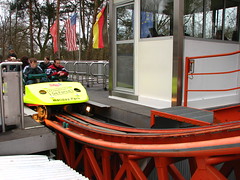 better pace than most of its competitors, sufficient enough for a very good ride but not much more. That most of that pace was missing from my own experience made me unable to put it anywhere on my top 25 list of steel coasters, especially after I had rides such as Blue Fire, iSpeed, Nemesis and (yes) The Ultimate slip into more of those vacancies later during my European travels.
better pace than most of its competitors, sufficient enough for a very good ride but not much more. That most of that pace was missing from my own experience made me unable to put it anywhere on my top 25 list of steel coasters, especially after I had rides such as Blue Fire, iSpeed, Nemesis and (yes) The Ultimate slip into more of those vacancies later during my European travels.
However… while my relationship to Expedition GeForce might not fare very well on a semi-arbitrary top 25 list, out of every coaster in Europe, it may still very well be the one ride towards which I hold the most affectionate memories. Never once during the day was a train sent out without at least a few empty seats that could be filled, and with an open re-ride policy it made the 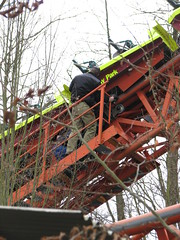 day essentially one never-ending ERT for me. My first mini-marathon that morning saw nine cycles, before on the last ride, halfway up the lift, the cable winch came to a sudden dead stop. It was moving fast enough that the train still had enough moment to roll forward a couple feet before freely rolling back down, reconnecting with the winch with considerable force and noise. “Are you sure traditional anti-rollbacks aren’t necessary for this system!?” We waited it out for some five to ten minutes as an employee ran up the stairs to tell everyone (in German) everything was okay and they’d have it fixed in a few minutes.
day essentially one never-ending ERT for me. My first mini-marathon that morning saw nine cycles, before on the last ride, halfway up the lift, the cable winch came to a sudden dead stop. It was moving fast enough that the train still had enough moment to roll forward a couple feet before freely rolling back down, reconnecting with the winch with considerable force and noise. “Are you sure traditional anti-rollbacks aren’t necessary for this system!?” We waited it out for some five to ten minutes as an employee ran up the stairs to tell everyone (in German) everything was okay and they’d have it fixed in a few minutes.
After those first nine rides I got one more in around noon before the coaster went down for maintenance for several hours. I was slightly worried those ten rides might have been all I’d get for my time at Holiday Park, but before 3:00pm it was once again operational. I returned around 3:30, knowing I’d have to leave to catch the bus back to the train station before 6:00pm. I waited for the front row, got my eleventh ride in.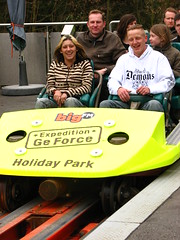 Then I moved to a seat further back on the next cycle, twelve rides. I continued to stay on,
Then I moved to a seat further back on the next cycle, twelve rides. I continued to stay on,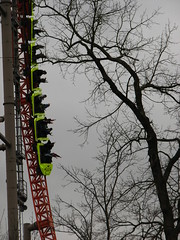 sometimes switching seats, sometimes staying put for several rides in a row, occasionally even getting a cycle when no one was waiting for the front row, until by the end of the day I had racked up a total of 36 rides on Expedition GeForce. This was not a rushed day by any means, in fact it was one of my most relaxing of during my spring break trip.
sometimes switching seats, sometimes staying put for several rides in a row, occasionally even getting a cycle when no one was waiting for the front row, until by the end of the day I had racked up a total of 36 rides on Expedition GeForce. This was not a rushed day by any means, in fact it was one of my most relaxing of during my spring break trip.
There are few greater pleasures than finding a seat on an enjoyable coaster,and staying there until the day grows long, getting a feel for every nuance in the track, every sight to be seen along the surroundings, trying it with my eyes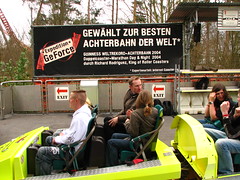 closed, trying it with my hands up the whole time, trying it while looking backwards, or to the left, or the right. Best of all is finding a spot to people watch, as a new set of folks are waiting on the station each time, each with their own set of visible fears or excitement or apathy, and their own story to tell you during the course of a two minute ride if you watch closely enough. There’s no such thing as a language barrier when you’re sharing a roller coaster ride.
closed, trying it with my hands up the whole time, trying it while looking backwards, or to the left, or the right. Best of all is finding a spot to people watch, as a new set of folks are waiting on the station each time, each with their own set of visible fears or excitement or apathy, and their own story to tell you during the course of a two minute ride if you watch closely enough. There’s no such thing as a language barrier when you’re sharing a roller coaster ride.
Eventually I had to leave, and I was sad for that as I really enjoyed my time at Holiday Park. I will most definitely make it a high priority to return should I ever find myself in Germany again… hopefully sometime when the weather’s warmer and the coasters faster.
Surprising. I didn’t think Expedition GeForce would be so inhibited by the cold. It seems these Intamins react like this pretty strongly but I thought it was to a lesser extent the more compact they become… I guess not.
Riding to the point of people watching while on a coaster with an open re-ride policy sounded the most inviting in your report. Very enjoyable and a rare opportunity it seems.
Lighthouse tower sounds cool also. I want to try one of these. I think I would prefer the treetops rather than the midways for a view. They seem fun.
As every Vekoma fan should know, the corkscrew with bayern curve only has a 6 car train.
Besides this little mistake, a great review of my favorite Vekoma design.
Whoops. I think I was still trying to misdirect readers towards the wrong coaster at that point, and got a fact mixed up. Thanks for pointing it out. This was the one review I’ve ever written that was much more effective as the text-only version I posted on rec.roller-coaster.